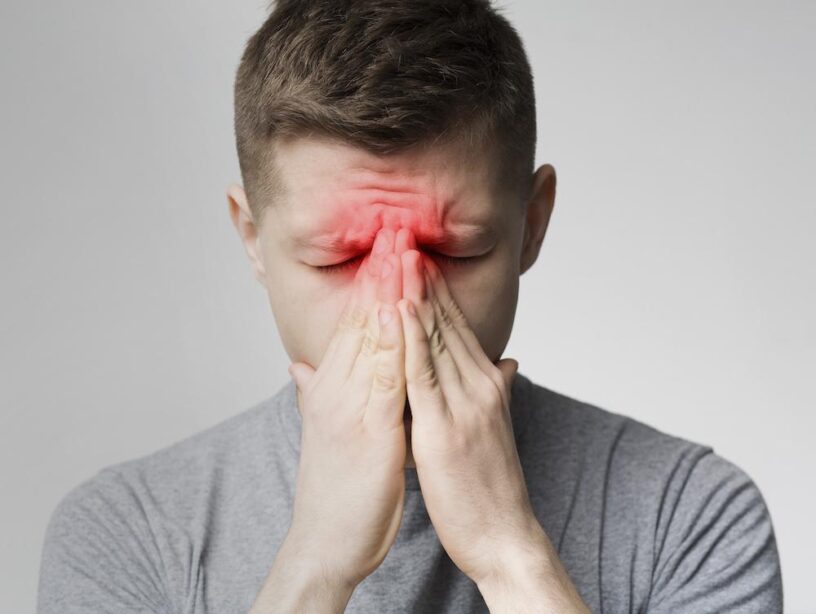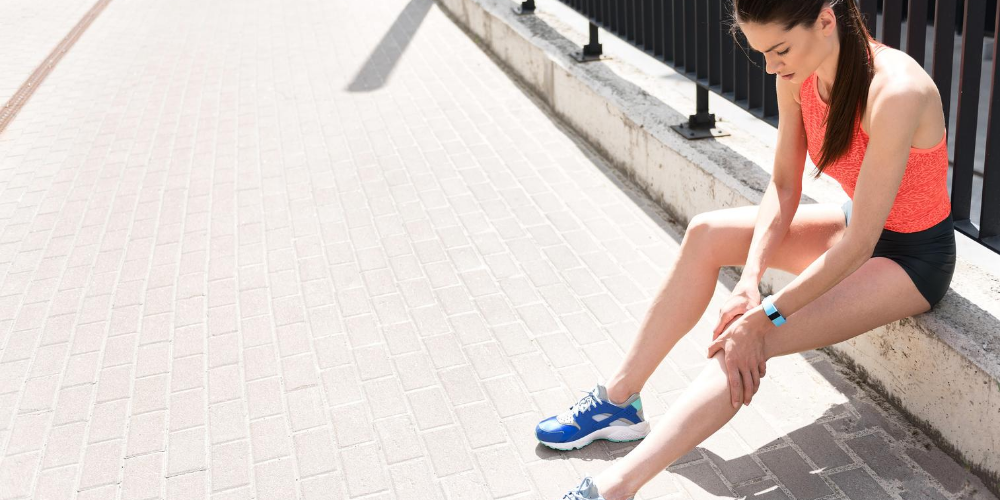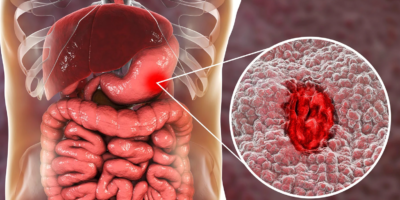In fact, one study found that more than 80 percent of people with the common cold had signs of sinusitis, or sinus inflammation, on CT scans. Here’s what happens: Viral respiratory infections, as well as allergies and air pollutants such as tobacco smoke, inflame the upper respiratory membranes. The resultant swelling and excess mucus block the tiny openings that connect the normally air-filled sinuses with the nasal cavities. The mucus normally made by the cells lining the sinuses starts to accumulate, generating a sense of pressure. If bacteria have become trapped within the sinuses, they start to multiply, leading to symptoms of acute bacterial sinusitis.


1. Sinus Tea
How it works: Staying hydrated by drinking lots of warm, clear liquids helps keep respiratory mucus thin and easy to expel. Peppermint provides a sense of decongestion.
- PREPARATION:
- 2 peppermint tea bags
- 1 cup (235 ml) water
- DIRECTIONS: Boil the water and pour it into a cup. Add the tea bags (two, to make it strong). Steep for 10 minutes, covering the top with a saucer to keep peppermint’s essential oils from escaping. Inhale the aroma through your nose as you sip.
- YIELD: 01 SERVING
2. Pepperminty Steam Inhalation
How it works: Peppermint has antiinflammatory, analgesic, antibacterial, and subtle antihistamine effects. By breathing in through your nose, your sinuses get the peppermint’s immediate effect.
- PREPARATION:
- 2 cups (475 ml) water
- 2 to 3 drops peppermint essential oil
- DIRECTIONS: Boil the water in a large pot. Pour into a bowl. Add the peppermint oil. Leaning over, drape a towel over your head to trap the vapors. Inhale through your nose for about 1 minute. Repeat four or five times a day.
- YIELD: 01 SERVING
- WARNING: If you want to try this with a child, use only 1 drop of essential oil. Stay with your child to ensure that small hands don’t touch hot objects or tip over the bowl.
- NOTE: Don’t lean over so far that the steam feels too hot. If you have asthma, inhale steam without any essential oils, which may trigger airway spasms in vulnerable people. If plain steam causes no problems, cautiously inhale the steam with only 1 drop of essential oil. Stop if it makes you cough or wheeze.
3. Warm Washcloth Relief
How it works: The heat breaks up the congestion and soothes inflamed mucous membranes.
- PREPARATION: Hot water
- DIRECTIONS: Dampen a washcloth with hot water—not too hot to the touch. Wring out excess moisture. Apply to the affected sinus area. Remove when no longer hot. Repeat several times a day.
4. Nostril Cleanse
How it works: The salt solution helps remove excess mucus and microbes clinging to nasal passages. It does not clean out the sinuses. However, some studies show that nasal irrigation helps manage acute and chronic sinusitis.
- PREPARATION:
- ½ cup (120 ml) sterile water (see warnings)
- ¼ teaspoon salt (without iodine or preservatives)
- ¼ teaspoon baking soda
- DIRECTIONS: Have ready a ceramic neti pot or clean creamer bowl (see warnings). Mix sterile water, salt, and baking soda in a clean neti pot. Leaning over the sink, angle your head so that one nostril is down and one is up, with your forehead slightly higher than your chin. Insert the spout of the neti pot into the top nostril. Pour. Water will drain out of the downward-facing nostril. (If a nostril is completely blocked, quit.) Switch sides. Gently blow your nose. Discard any excess solution. Wash the neti pot in hot, soapy water or the dishwasher. Repeat two to three times a day, making a fresh batch each time.
- YIELD: 01 APPLICATION
- WARNING: Sterile water is essential. Two deaths have been reported from people using tap water contaminated with amoebas. Health experts maintain that nasal washes are safe—as long as you use sterile water. Either boil the tap water for 1 minute (3 minutes if you live above 6,600 feet [2 km]) or buy distilled or sterilized water. Allow boiled water to cool before attempting nasal irrigation. Use a ceramic, not plastic, neti pot, which resembles Aladdin’s lamp. These are available in most natural food stores and from online retailers. Most nasal irrigation pots sold in drug stores are plastic, which is difficult to sterilize.
- NOTE: Avoid nighttime sinus rinses; remain upright for a couple of hours to encourage drainage.
5. Sinus-Clearing Spicy Soup
How it works: Ever notice that spicy foods make your nose run, making the thin, watery mucus easier to expel? Cayenne peppers contain capsaicin. Spicy plants, such as horseradish and mustard, contain allyl isothiocyanate. Both plant chemicals stimulate mucous membranes to make copious, thin mucus. Spicy foods, such as cayenne peppers and garlic, are also generally antimicrobial. Garlic also enhances immune function; cayenne can help reduce pain.
- PREPARATION:
- 1 cup (235 ml) vegetable or chicken stock
- 1 garlic clove, minced
- ¹∕8 teaspoon cayenne pepper
- DIRECTIONS: Pour the stock into a small pan. Heat until steaming. Stir in the garlic and cayenne and serve immediately.
- YIELD: 01 SERVING
6. Horseradish “Gum”
How it works: Horseradish, sometimes called “sting nose,” contains chemicals that irritate mucous membranes. In response, your upper respiratory passages release thin, copious mucus, thereby helping you clear your nasal passages. Horseradish is also antibacterial and has anti-inflammatory properties.
- PREPARATION: 1 teaspoon (5 g) prepared horseradish
- DIRECTIONS: Put the horseradish in your mouth. Chew, allowing the aromas to work as a decongestant. Spit out any remaining substance.
- YIELD: 01 APPLICATION
Fact or Myth?
- OVER-THE-COUNTER SINUS MEDICATIONS ARE USUALLY THE MOST EFFICIENT TREATMENTS FOR A SINUS INFECTION. Myth. Most products on the market contain a combination of antihistamines, decongestants, and pain relievers (usually acetaminophen). Studies have not proven that antihistamines and decongestants help. Both have side effects. Because antihistamines thicken the mucus, some experts suspect they may actually increase the risk of sinusitis developing. If you have a headache, pain relievers can make you more comfortable. Be careful not to exceed the maximum daily dosage of 3,000 milligrams. The danger comes in taking more than one medicine containing acetaminophen (e.g., Tylenol and a combination sinus medicine). In higher doses, acetaminophen can injure the liver.
Lifestyle Tip
- Chew a few green peppercorns to relieve sinus congestion. Pepper, known as a “head herb” in ayurvedic medicine, is said to clear congestion and act as an expectorant. studies show that it is antioxidant, immune-stimulating, and antiasthma.
- Exercise has a decongesting effect. If you feel up to it, go for a brisk walk or cycle. If you have a fever, headache, or otherwise feel lousy, rest.
- Turn on the shower and close the bathroom door for a sauna. The steam opens airways and loosens the mucus in your sinuses as it relaxes you.
- Blow your nose the right way: close one nostril by pressing with your finger and blow gently to clear the other nostril. Blowing too hard will force the phlegm into your ear, causing an earache. And blow your nose regularly—don’t sniff the infected mucus back into your nose and sinuses.
When to Call the Doctor
- If you have any concerns that you have bacterial sinusitis, contact your doctor. The research on whether antibiotics make much difference is inconclusive. Many doctors prescribe on a case-by-case basis. If you develop a high fever, confusion, or swelling around your eyes or over your sinuses, seek immediate treatment. You may have developed a serious complication. Also, call your doctor’s office if you have persistent (lasting longer than two weeks) or recurring symptoms of sinusitis.






Leave a Reply